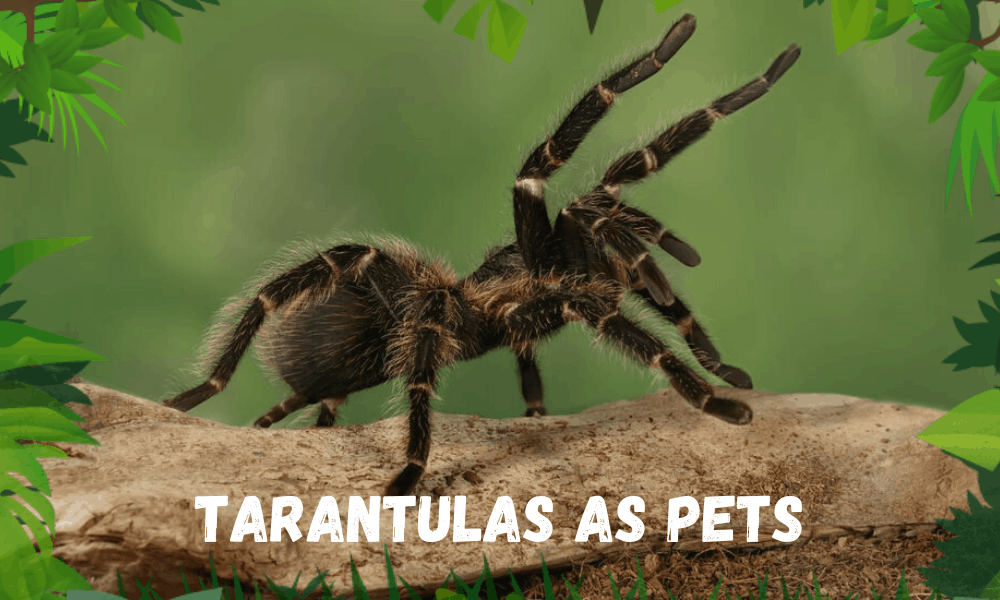Do tarantulas really make good pets? Well, that really depends on a few factors, namely, what the keeper intends on getting out of having a pet tarantula.
If you are in search of a cuddly pet to snuggle with on a cold night, then a tarantula is not for you. If you’re looking for a critter to carry around with you on your shoulder when you go shopping, then a tarantula is not for you.
However, if you are searching for a truly unique and fascinating pet, one that requires minimal daily maintenance and even less physical contact, then look no further. A tarantula is for you.
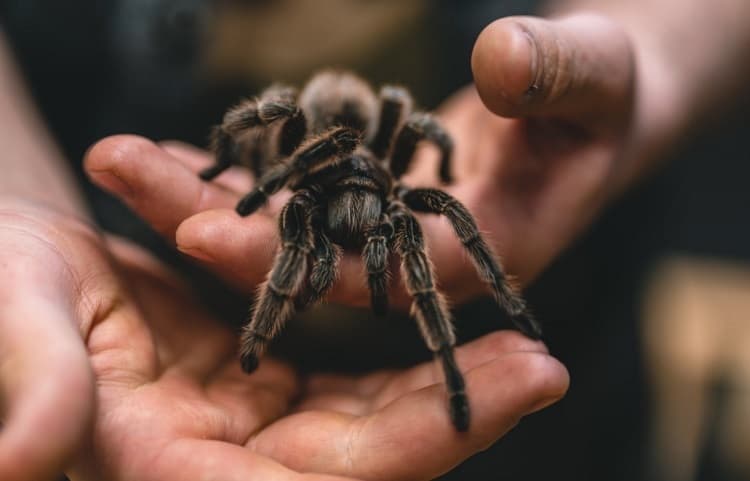
Why Keep a Tarantula?
Why not? Once you overcome the cultural taboo involved with keeping spiders and tarantulas as pets, you will quickly realize how incredibly unique these animals are. Despite being one of the earth’s oldest creatures, tarantulas are highly evolved for their lifestyle. They are perfectly suited for hunting and reproducing in a myriad of environments. There is no end to what you can learn from observing these arachnids.
Tarantulas range in size from only an inch or so to relative giants measuring nearly a foot across. However, the vast majority of species stay small enough to be safely and comfortably housed in a standard 5 gallon terrarium.
Additionally, tarantulas are one of the most low maintenance pets you will find.
Once the habitat is initially set up, all that’s left is a weekly or twice-a-week feeding, and regular misting of the terrarium to maintain proper humidity. Most tarantulas can be maintained in the upper 70s to mid 80s year round, depending on where you live. In most climates, this means little or no supplemental heating is required to maintain these animals.
The First Step is the Hardest
The most difficult thing for most people is getting close enough to a tarantula for the first time to see them for what they really are. Not scary beasts out to bite you, but instead, incredibly agile creatures capable of some of the animal kingdoms most astonishing feats.
I, for one, was once very uncomfortable around tarantulas. I simply had never had any close or hands on experience with them, and instead of knowing them for what they are, knew them in the negative light portrayed by the media. Once I got past my initial ambivalence and took a closer look, I finally realized what I’d been missing,
And since then I’ve never looked back. In fact, discovering tarantulas has had such a profound effect on my view of unfamiliar animals that I have opted to share my experience and advice with you here.
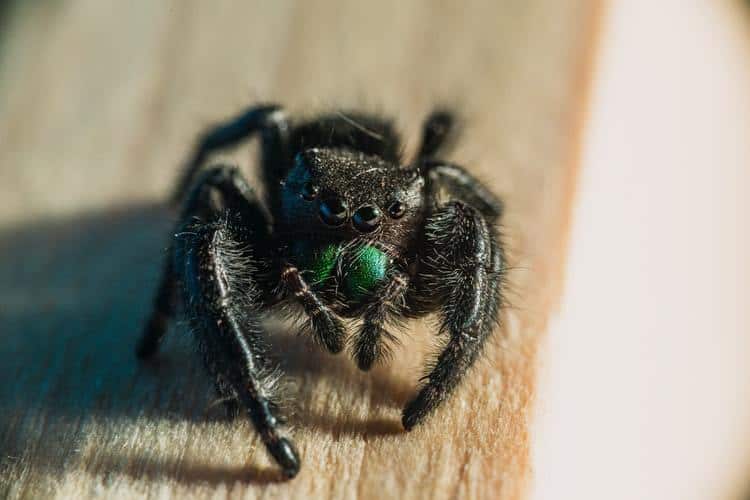
Choosing a Tarantula
When choosing a tarantula for the first time, there are a few things to consider. Among these are ease of keeping (habitat type), adult size, and temperament. Different species of tarantulas are going to have different needs.
For example, some species come from harsh, dry deserts, and depend on deep burrows to escape the heat. Others live high in the rainforest canopies of Asia and South America.
Obviously, keeping a tropical tree spider in a dry setup with no vertical height for climbing would result in a stressed and short lived animal. Instead, research the origins, behaviors, and needs of the species that interest you before you buy it, or begin constructing habitat.
The reality remains, that because tarantulas are such natural survivors they can and will adapt to even sub-optimal housing conditions. However, this is not an excuse for abusing your pet or for cutting corners in its care.
It is important to consider the adult size of the animal you are contemplating. While Rose Hair Grammostola Rosea and Red Knee Brachypelma Smithi tarantulas only attain an adult size of 3 to 4 inches, others such as the Goliath Bird Eater Theraposa Blondi will attain a leg span as big across as a dinner plate.
It should go without saying that such a large animal (even a tarantula) would require ample space in order to live a comfortable, stress-free life. For beginners, one of the smaller species mentioned above would be a better choice. When mature a single female (generally the larger of the two sexes) can be maintained in a small enclosure the size of a 5 gallon glass tank, or even smaller.
Next, consider the temperament of the species. Tarantula temperaments are as varied as their size and appearance. Some species, such as Chilean Rose Hairs G. Rosea are naturally docile and slow moving animals that can be easily handled by the novice keeper.
At the other end of the spectrum are the “baboon spiders” of sub-Saharan Africa. This group of poorly classified tarantulas attain larger sizes (up to 7 inches) and are completely unsuitable for handling.
These naturally nervous and aggressive tarantulas will not hesitate to stand their ground, lunge at a keeper, and potentially inflict a painful bite. If you don’t think you are ready for this type of responsibility then start off with something more calm, and gain experience before working your way up to more advanced species.
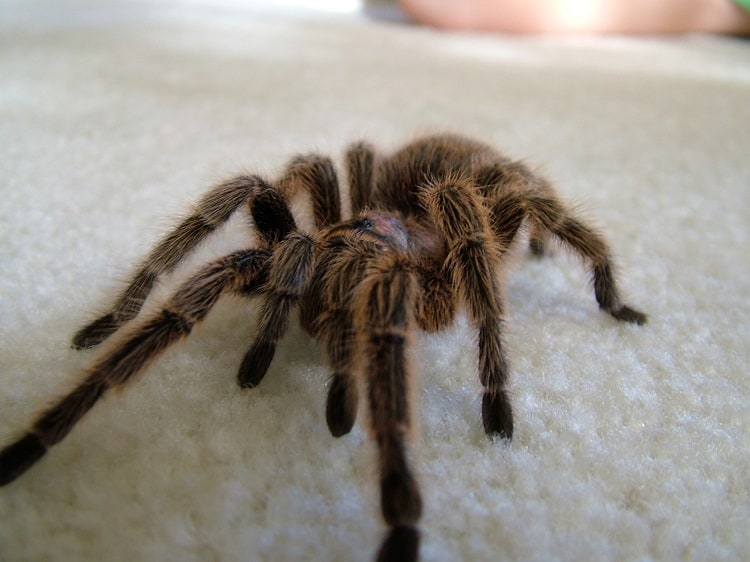
Tarantula Homes
One of the largest draws to tarantula keeping is that of their relatively simple housing requirements. Most species spend about 90% of their lives hidden in snug burrows or tree hollows waiting for nightfall.
As a result, it is not necessary to provide huge, expansive enclosures for most tarantulas. As always, there will be exceptions, but for the most part shoebox-sized enclosures work well.
A good rule of thumb for terrestrial species is that the floor space of the cage should be 3-4 times the size of the tarantula when its legs are extended. In other words, if you could hypothetically clone your pet, you should be able to put 3-4 of them into the enclosure without them overlapping.
To reptile people, (and certainly to mammal people) this may not seem like much space, but in fact, it is slightly larger than the enclosures often utilized and recommended by breeders. As a naturalist at heart, I feel that all animals should be given as much space as is reasonable for the species.
However, the trick with tarantulas is to not go too big. Because tarantulas depend mostly on tactile (feeling) senses to explore their environment, too large of a cage would actually cause stress to most species. Animals placed in these large enclosures tend to constantly pace the enclosures perimeter to no end.
The exception to this rule would be large enclosures that are densely landscaped with various hiding structures for the tarantula to explore. Remember, a happy tarantula is a tarantula that can feel his environment around him.
Also keep in mind, some species climb, and some burrow. Most will require at the very least a small shelter that it can fit in comfortably. Arboreal species can be kept in taller encloses with slightly less floor space than previously recommended.
Likewise, deeper enclosures can be utilized for burrowing species. Be sure to know the habits of the species you are getting before you choose and design an enclosure.
Personally, I keep tarantulas because I find them beautiful and fascinating to watch. Thus all of my animals are st up in naturalistic vivaria that lend well to display in my home. Other people are less concerned with seeing their tarantulas, and simply want to keep them alive and happy.
These individuals have found various ways to economically house large numbers of arachnids. Among these are mason jars, plastic tubs and shoeboxes, and even tupperware.
Be for-warned, that although this may seem appealing to the budget conscious tarantula keeper, if you expect to gain anything at all form having a tarantula as a pet, set it up so you can see it.
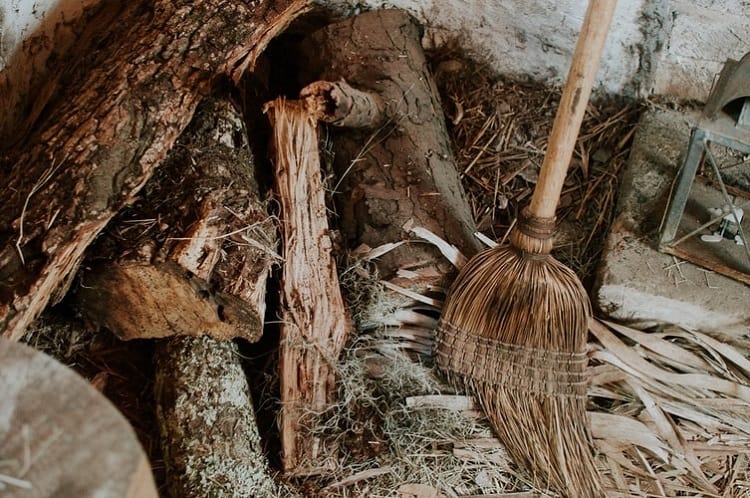
Female tarantulas (most pet-shop specimens are female) can live over 20 years. That’s a long term commitment. You might as well go all out to begin with and save yourself the trouble later.
I’m not telling you this to get you to go out and spend all your hard-earned money on tarantula set-ups. I’m telling you this because it’s one of the toughest lessons that I’ve learned the hard way.
So what does make a good tarantula enclosure? If you live in a climate where supplemental heating is not needed in the winter, then plastic Herp-Havens (formerly Knitter-Keepers) work great. They are inexpensive, lightweight, and secure.
However, they can not be heated (both lamps and pads would melt the enclosure) and will become scratched over time. This leaves us with my number one choice for keeping tarantulas; glass terrarium. 3-5 gallon models work well for most species, with a few individuals requiring a 10 gallon tank.
Extremely large species, such as King Baboons and Bird Eaters may require even larger tanks, but these species are recommended for experienced keepers and are outside the scope of this article.
I highly recommend a tank specially designed for reptiles, as opposed to a converted fish tank. Tarantulas are very agile and can be incredible escape artists. Tanks with sliding and locking screen tops are perfect, and can generally be bought for under $20. These tanks will last forever (unless you drop it), can be gently heated, and have excellent ventilation for both dry and humidify-loving species.
Substrates, Decor, Etc.
Once you have selected an appropriate enclosure for your tarantula, filling it in is quite simple. At the very least, the following 3 components must be present: appropriate substrate, a shelter, water dish. On the other end of the spectrum, there is no limit as to how intricately you choose to decorate the enclosure.
However, keep in mind that many species will form intricate networks of webs within the enclosure. If you place too many items in the cage it will become impossible to clean, feed, and water your pet without totally destroying its webbing. It is not difficult to design a simple, yet aesthetically pleasing enclosure. Simple experimentation will reveal what works for you and for your pet.
There are probably as many opinions on proper substrates for tarantulas as there are tarantula species in the world. Every tarantula keeper will have his or her favorite for their own reasons. I will make no claims as to what substrate is the right or wrong one.
Instead, I will explain a few of my personal favorites that have worked flawlessly for me over the years. In general I prefer natural, organic substrates. In other words, I don’t like plastic cage carpets, or aquarium gravel.
It is important to have a substrate that maintains proper humidity (even desert species require some degree of humidity fluctuation. Likewise, it should be one that is not overly dusty, dirty, or heavy.
My first choice of bedding is pure orchid bark or orchid bark mixed with a coconut husk peat bedding. The amount of coconut husk bedding (much like sterile potting soil) is directly related to the ambient humidity I wish to achieve.
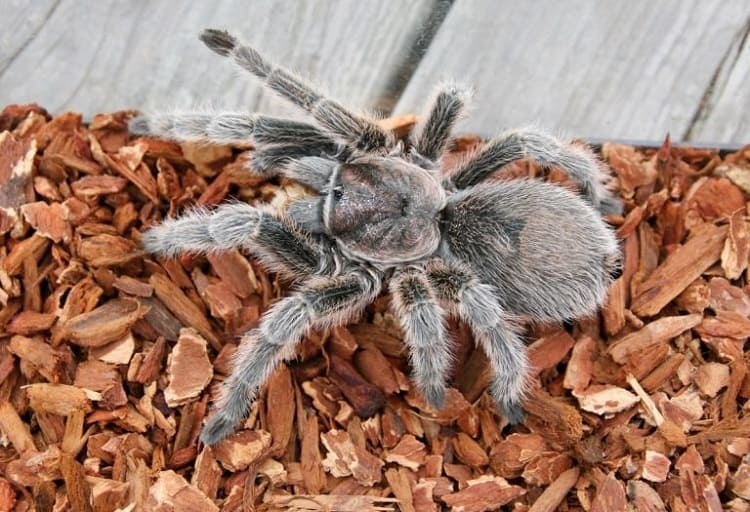
More coconut husk bedding will equal higher humidity, and longer periods between misting to maintain the humidity. What makes bark such a favorite of mine is that it works just as well for dryer species.
I usually rinse it well with tap water to remove any dust that may have formed during transport, then add it to my enclosure. It will dry out in a few days to a very clean, and dry substrate.
My second favorite substrate is pure vermiculite. This product is manufacture for gardening, and used commonly in reptile egg incubation. It has been used for years in Europe as a cheap and reliable bedding. It can be kept very moist or dry, and when wet can easily hold the shape of a burrow.
Dryer substrates tend to be inadequate for holding the form of burrows, and this must be considered when designing the habitat. Another plus is that vermiculite is very neat looking. It has a metallic sheen to it that can be very attractive. In the U.S. vermiculite is now available asbestos-free, and this is the grade of vermiculite I recommend.
Being as adaptable as they are, it may seem obvious that pretty much anything will make a good tarantula substrate. To an extent, this is true. However, all factors considered, the above few options have worked the best for me.
It should also be noted that the above three ingredients (bark, sterile soil, and vermiculite) can be mixed up in an endless number of combinations to form substrates perfect for your needs.
Decorating the enclosure is simple. The bare minimum would be a simple hiding structure such as a half-log or coconut hut. More naturalistic set-ups may include pieces of stone or driftwood to further make your pet feel at home.
However, you choose to do it, remember the basics; make your tarantula feel secure, but don’t overdo it. I would leave at least 25% of the floor space of the enclosure unobstructed and in the open for your tarantula to explore.
Given some time in their home, most tarantulas will begin to excavate their own hide-outs, some even moving around cage furnishings. This is good, let them do it. Your tarantula knows better than you do what it likes.
Many species will burrow deep into the substrate. If you have a burrowing species, be sure to keep the lower levels of the substrate moist enough to prevent the tarantulas’ tunnels from caving in.
Water and Humidity
Contrary to popular belief, tarantulas do drink water. Traditional wisdom indicated that tarantulas get all of the moisture that they need to survive from food. This may be true, depending on the size, age, and environmental conditions of the animal.
However, based on my personal observations, and those presented by other experts, the vast majority of tarantulas require and utilize water dishes. Without the added protection of a natural burrow, tarantulas will lose water faster than they can gain it through food consumption (Cloudsley-Thompson 1967).
Water should be always available and should be offered in a spill-proof dish that is large enough for the tarantula to fit its entire body in. Smaller dishes are simply too tiny for the tarantula’s sensory organs to perceive, and the water will be over looked.
Depth is another concern. Do not make the water much deeper than the distance between the ground and the tarantula’s underside. It is also advisable to provide some sort of island or ramp in the dish to provide an escape route for wayward feeder crickets, or weak tarantulas alike.
In the past, saturated cotton balls and sponges were popular fixtures in a tarantula tank. The belief was that the tarantulas would drink from the sponge with their fangs, while at the same time, the evaporative quality of the water would boost the humidity.
In actuality, all that this set-up achieves is a prime breeding ground for bacteria, fungi, and crickets. It is shocking how rapidly these tarantula sponges can become soiled. Do no use them. They are not necessary and may harm your pet.
Humidity inside the tarantula enclosure should be maintained at a level acceptable for the species you are keeping. In general, deep desert species do well with ambient humidity in the 40% to 60% range.
Even lower is acceptable if suitable moist shelters/burrows are present. Tropical species require higher humidity from 75% to 100%. Intermediate species will require levels in between. Maintaining proper humidity levels can be done easily by choosing a proper substrate, controlling ventilation, and regular misting.
Misting with room temperature water is by far the most common and simplest way to increase cage humidity. I would recommend spraying desert species lightly twice per week, and rain forest dwellers as much as twice per day.
Experimentation and the use of a quality humidity gauge will help you to determine the proper misting schedule for your specific set-up. Use bottled water, or distilled water for cage misting.
Using tap water will leave ugly water spots and mineral deposits on the walls of your enclosure. This simple tip will save you much frustration when it comes time to clean your tank.
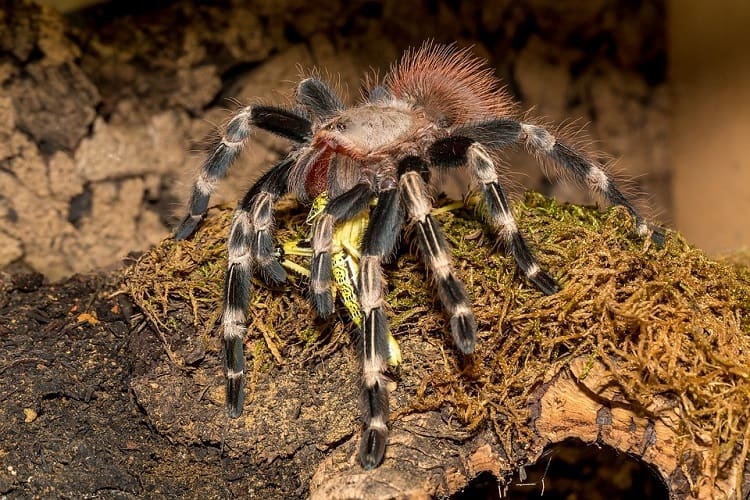
Feeding
Feeding tarantulas may be the simplest aspect of their care. Tarantulas have a varied diet in the wild consisting of both invertebrate and vertebrate prey. In captivity, small insects harvested specifically to feed other animals should make up the bulk of the diet.
Common foods include crickets, mealworms (all sizes), and roaches. Variety is the key, although crickets have proven themselves as being a healthy staple for many species. Larger tarantulas may eat small mice, birds, and even lizards both in the wild and in your home. Rodents should be fed minimally, with the bulk of any tarantulas diet being insects.
The size of the prey is the next consideration. Generally, tarantulas will tackle, kill, and eat prey that seems much too large for them to handle. However, prey that is too small may be ignored while too large of a food item may intimidate the tarantula.
Generally, I aim for feeding my tarantulas insects that are about 1/4 the size of their abdomen. Some species prefer larger prey, while others wait for smaller foods. You will have to experiment here to see what your tarantula prefers. But take caution to not offer food so large that it may injure your tarantula.
Food should be offered about once a week. Young, fast growing tarantulas may except food more often than that, but most will ignore food if they are still full from a previous meal. You should give your tarantula as many crickets as it will eat within a few hours, being careful to remove any uneaten food items.
This may result in your tarantula gorging itself, and then fasting for weeks or months. This pattern is perfectly safe and natural. Most average sized tarantulas will eat 2-3 adult crickets every 5-7 days.
Overfeeding does not tend to be an issue, as tarantulas will simply stop hunting once they are satiated. It for this reason that uneaten prey must not be left in the enclosure for any period of time. Hungry crickets and mealworms have been known to feed off of the creature they were supposed to be food for.
Dusting food items for tarantulas with a multi-vitamin is of little use. Many tarantulas will not eat the entire prey, instead, eating only the inside, and leaving behind the chitinous shell. So, in order to provide your pet with all of the minerals and vitamins that it would receive in nature, I recommend gut-loading the prey items.
Gut-loading is the term used for feeding prey items a super nutritious diet so that the prey item itself becomes fortified with a variety of essential vitamins and minerals.
Commercial insect gutloads are available, but a mixture of fresh fruits, veggies, and grains works well also. Allow feeder insects to gutload for at least 24 hours prior to feeding them to your tarantula.
Recommended Reading
So, you want to know even more about tarantulas? I have just the book for you. Pick up The Tarantula Keeper’s Guide by Stanley and Marguerite Shultz. This book is by far the most thorough tarantula book I have ever seen. It covers all aspects of tarantula anatomy, physiology, captive care, conservation, research, handling, and breeding. Absolutely nothing is left out.
Conclusion
As I stated earlier, the line between reptile and tarantula keepers is getting fuzzier every day. It seems to me that many hobbyists are content keeping both types of animals and enjoy each species for its own, unique wonders.
Hopefully, enough sound information has presented here so that at the very least, you are able to make an educated decision regarding whether or not a tarantula is right for you. In the best case scenario, my words have opened up a door for you that will lead to years of entertainment and education.
This article appears courtesy of LLL Reptile and is used with their permission.

